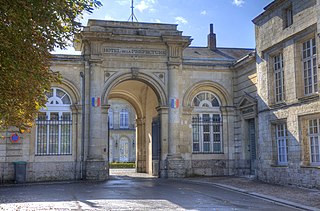
The Pas-de-Calais is a department in northern France named after the French designation of the Strait of Dover, which it borders. It has the most communes of all the departments of France, with 890, and is the 8th most populous. It had a population of 1,465,278 in 2019. The Calais Passage connects to the Port of Calais on the English Channel. The Pas-de-Calais borders the departments of Nord and Somme and is connected to the English county of Kent via the Channel Tunnel.

Vimy is a commune in the French department of Pas-de-Calais. Located 3.8 kilometers (2.4 mi) east of Vimy is the Canadian National Vimy Memorial dedicated to the Battle of Vimy Ridge and the Canadian soldiers who were killed during the First World War. The Memorial is also the site of two Canadian cemeteries.

Givenchy-en-Gohelle is a commune in the Pas-de-Calais department in the Hauts-de-France region of France. The village was destroyed during World War I but was rebuilt after the war.

Loos-en-Gohelle is a commune in the Pas-de-Calais department in the Hauts-de-France region of France.
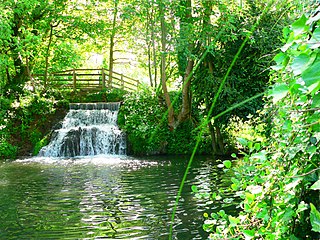
Souchez is a commune in the Pas-de-Calais department in the Hauts-de-France region of France. It is located 3.2 kilometres (2.0 mi) northwest of the Canadian National Vimy Memorial dedicated to the Battle of Vimy Ridge and the missing First World War Canadian soldiers with no known grave; the Memorial is also the site of two Canadian cemeteries.

The arrondissement of Lens is an arrondissement of northern France in the Pas-de-Calais department in the Hauts-de-France region. It has 50 communes. Its population is 367,839 (2016), and its area is 351.5 km2 (135.7 sq mi).

The arrondissement of Arras is an arrondissement of France in the Pas-de-Calais department in the Hauts-de-France region. It has 357 communes. Its population is 248,929 (2016), and its area is 2,245.3 km2 (866.9 sq mi).

Bullecourt is a commune in the Pas-de-Calais department in the Hauts-de-France region in France.

Bully-les-Mines is a commune in the Pas-de-Calais département in northern France. It forms part of the Lens-Liévin agglomeration community, which encompasses 36 French communes and 250,000 inhabitants. For many years it was a major coal mining center.

Neuville-Saint-Vaast is a commune in the Pas-de-Calais department in the Hauts-de-France region of France. It is located 3.2 kilometres (2.0 mi) south of the Canadian National Vimy Memorial dedicated to the Battle of Vimy Ridge. The Memorial was built on Hill 145, the highest point of the ridge to commemorate the battle and the Canadian soldiers who lost their lives during the First World War. The Memorial is also the site of the Canadian Cemetery No. 2, Neuville-St.-Vaast and Givenchy Road Canadian Cemetery, Neuville-St.-Vaast.
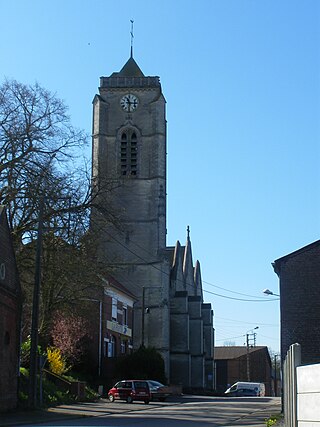
Vaulx-Vraucourt is a commune in the Pas-de-Calais department in the Hauts-de-France region of France.

Arleux-en-Gohelle is a commune in the Pas-de-Calais department in northern France.

Chérisy is a commune in the Pas-de-Calais department in the Hauts-de-France region of France.
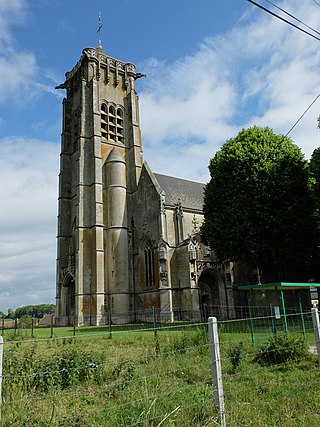
Écoust-Saint-Mein is a commune in the Pas-de-Calais département in the Hauts-de-France region of France.
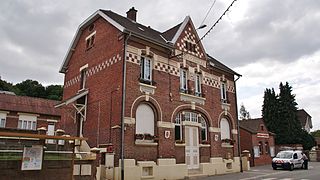
Farbus is a commune in the Pas-de-Calais department in the Hauts-de-France region of France. It is located seven kilometres from the Canadian National Vimy Memorial dedicated to the Battle of Vimy Ridge and the missing First World War Canadian soldiers with no known grave; the Memorial is also the site of two Canadian cemeteries.

Feuchy is a commune in the Pas-de-Calais department in the Hauts-de-France region of France. It is a small village, with a little more than 1000 inhabitants, and had only about 500 inhabitants in 1914. It is situated two kilometers east of Arras. During World War I, in 1914, it was occupied by German troops. British troops took over the Arras sector in March 1916. On April 9, 1917, the British operation "big push" led to advancement of several miles to the east in a battle with one with the most casualties per day, and Feuchy was liberated. The German offensives placed Feuchy under their control in 1918 until the Canadians cleared the area in August 1918. The population of Feuchy was evacuated and the village was completely destroyed.

Monchy-le-Preux is a commune in the Pas-de-Calais department in the Hauts-de-France region of France.

Oppy is a commune in the Pas-de-Calais department in the Hauts-de-France region of France.
The canton of Brebières is an administrative division of the Pas-de-Calais department, in northern France. It was created at the French canton reorganisation which came into effect in March 2015. Its seat is in Brebières.
The Communauté de communes Osartis Marquion is a communauté de communes, an intercommunal structure, in the Pas-de-Calais department, in the Hauts-de-France region, northern France. It was created in January 2014 by the merger of the former communautés de communes Osartis and Marquion. Its area is 330.6 km2, and its population was 42,277 in 2018. Its seat is in Vitry-en-Artois.






















